What'stheweatherlike教学设计
- 格式:doc
- 大小:57.50 KB
- 文档页数:4
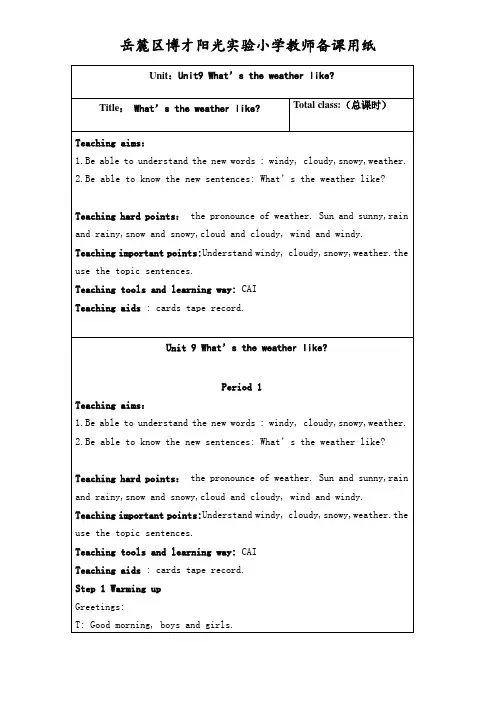
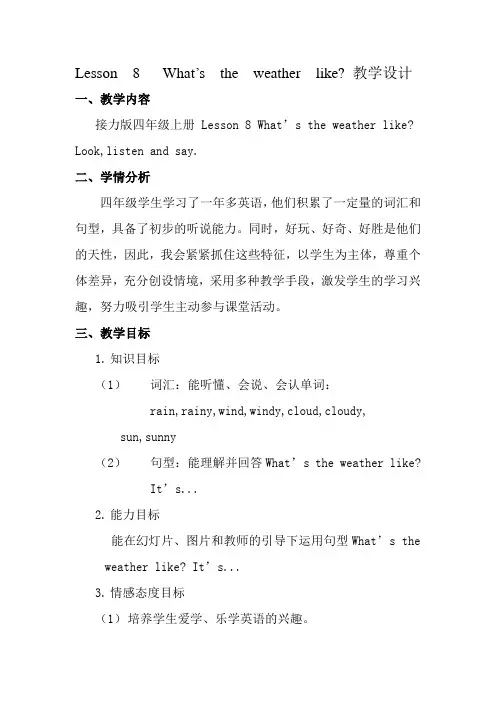
Lesson 8 What’s the weather like? 教学设计一、教学内容接力版四年级上册 Lesson 8 What’s the weather like? Look,listen and say.二、学情分析四年级学生学习了一年多英语,他们积累了一定量的词汇和句型,具备了初步的听说能力。
同时,好玩、好奇、好胜是他们的天性,因此,我会紧紧抓住这些特征,以学生为主体,尊重个体差异,充分创设情境,采用多种教学手段,激发学生的学习兴趣,努力吸引学生主动参与课堂活动。
三、教学目标1.知识目标(1)词汇:能听懂、会说、会认单词:rain,rainy,wind,windy,cloud,cloudy,sun,sunny(2)句型:能理解并回答What’s the weather like?It’s...2.能力目标能在幻灯片、图片和教师的引导下运用句型What’s the weather like? It’s...3.情感态度目标(1)培养学生爱学、乐学英语的兴趣。
(2)培养学生关注天气的习惯。
(3)培养学生合作的精神和自主探究的能力。
四、教学重难点1.重点:能听懂、会说、会认单词rain,rainy,wind,windy,cloud,cloudy,sun,sunny;能灵活运用句型What’s the weather like? It’s...2.难点:sun,sunny的正确发音及What’s the weather like? It’s...的灵活运用。
五、教学资源电子白板、单词卡片、图片等。
六、教学过程1.Warming up 2分钟师:Hello,boys and girls! Nice to meet you!生:Nice to meet you,too!师:Today is sunny. I am very happy, so let’s enjoy a song .(出示课件2,点击植入“rain,rain,go away”的动画视频播放课件3。
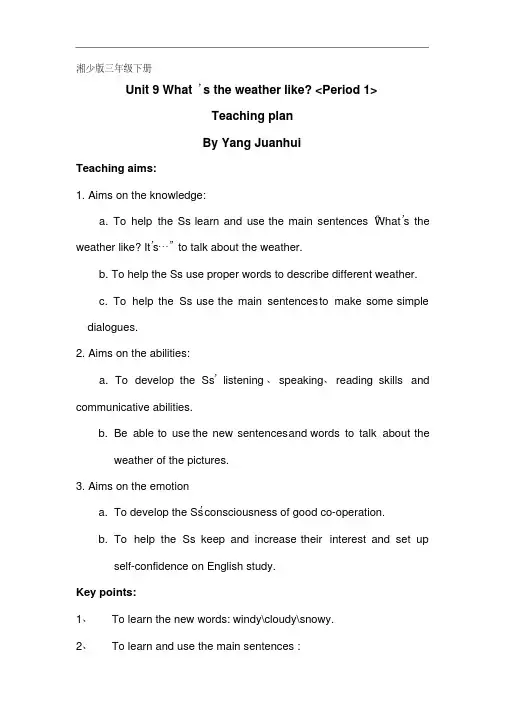
湘少版三年级下册Unit 9 What’ s the weather like? <Period 1>Teaching planBy Yang JuanhuiTeaching aims:1. Aims on the knowledge:a. To help the Ss learn and use the main sentences “What’s the weather like? It’s…” to talk about the weather.b. To help the Ss use proper words to describe different weather.c. To help the Ss use the main sentences to make some simple dialogues.2. Aims on the abilities:a. To develop the Ss’listening、speaking、reading skills and communicative abilities.b.Be able to use the new sentences a nd words to talk about theweather of the pictures.3. Aims on the emotiona.To develop the Ss’ consciousness of good co-operation.b.To help the Ss keep and increase their interest and set upself-confidence on English study.Key points:1、To learn the new words: windy\cloudy\snowy.2、To learn and use the main sentences :What’s the weather like? It’s …Difficult points:1、Talk about different weather on the pictures by using the question.2、The pronunciation of the word: weather.Teaching aids:some pictures, some word cards, some fruits, a magic boxTeaching steps:Step 1: Revision1.Greetings.2.Warm up: Let’s chant.3.Talk about the fruits.Step 2: Presentation1. Use word cards to revise the weather we have learned in last Unit .Choose one or two to read. Use the words to express: I like a____ day. I don’t like a ______ day.2. All these words are about: weather(天气).Read it. Spell it. Play a finding game to practice the word.3. Use the picture of sunny and rainy to present and practice the main sentence:What’s the weather like? It’s sunny\rainy.Guess the question’s meaning. Look at other pictures and try to answer. Then practice asking the question. Ask some pairs to use the twopictures to ask and answer about the weather.4.Talk about two photos. Try to communicate with your friends.e pictures and word cards to present 、learn and practice three newwords:What’s the weather like? It’s windy\cloudy\snowy.6. Use the main sentence to talk about the weather today.Step 3: Practice1.Play a guessing game: The teacher chooses one word. Please guess theweather. T: What’s the weather like? S1: It’s windy. S2: It’s rainy…Who is right? Who is lucky?2.Recognize the weather signs. Help the Ss know that there is a same yfor each word: sunny\rainy\windy\cloudy\snowy.3.Look at the book. Listen point and repeat the word of Part B.4.Play a game: The magic box.5.Look at six photos. Choose two photos to talk the weather on it withyour partners. Ask some pairs to show their dialogues.Step 4: Homework1.Listen to Part B for three times.2.Copy the words of Part B for twice.3.Talk with your friends about the weather everyday.。
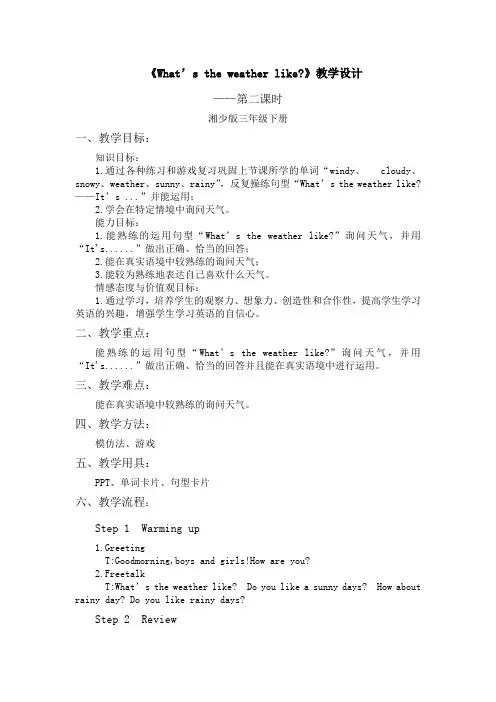
《What’s the weather like?》教学设计——第二课时湘少版三年级下册一、教学目标:知识目标:1.通过各种练习和游戏复习巩固上节课所学的单词“windy、 cloudy、snowy、weather、sunny、rainy”,反复操练句型“What’s the weather like? ——It’s ...”并能运用;2.学会在特定情境中询问天气。
能力目标:1.能熟练的运用句型“What’s the weather like?”询问天气,并用“It's......”做出正确、恰当的回答;2.能在真实语境中较熟练的询问天气;3.能较为熟练地表达自己喜欢什么天气。
情感态度与价值观目标:1.通过学习,培养学生的观察力、想象力、创造性和合作性,提高学生学习英语的兴趣,增强学生学习英语的自信心。
二、教学重点:能熟练的运用句型“What’s the weather like?”询问天气,并用“It's......”做出正确、恰当的回答并且能在真实语境中进行运用。
三、教学难点:能在真实语境中较熟练的询问天气。
四、教学方法:模仿法、游戏五、教学用具:PPT、单词卡片、句型卡片六、教学流程:Step 1 Warming up1.GreetingT:Goodmorning,boys and girls!How are you?2.FreetalkT:What’s the weather like? Do you like a sunny days? How about rainy day? Do you like rainy days?Step 2 Review1.PPT依次出示单词卡片,复习单词;1>.请同学认读单词或当小老师带读;2>.老师进行带读,包括升降调及拼写;3>.全班齐读单词。
2.Game:迅速出示单词卡片,学生需快速反应并大声说出对应的单词。
Step 3 Presentation and drill1.老师先引导学生关注今天的天气,再提问:What's the weather like?2.说出“It's.......”引导学生用英语回答天气。

外研版七年级上册英语《Unit 2 What's the weather like?》教案教材分析:本节课是外研版七年级上册Starter Module 4 My everyday life《Unit 2 What's the weather like?》,主要围绕天气的话题展开。
学生已经学过一些基本的日常生活用语和表达方式,现在将学习如何用英语谈论天气。
通过教材中的对话、练习和活动,学生将掌握描述天气的词汇和表达方式,培养他们在日常生活中用英语交流天气的能力。
教学目标:1. 理解并掌握本单元的核心词汇和表达方式。
2. 能够用英语谈论天气,包括询问天气、回答天气情况以及表达个人喜好。
3. 能够根据实际情境进行角色扮演对话,运用所学内容进行交流。
教学重点和难点:重点:理解单元中的词汇和表达方式的含义和用法。
难点:用英语谈论天气。
学情分析:学生是七年级的初学者,对英语表达天气的方式可能还不熟悉。
他们已经学过一些基本的日常生活用语,具备一定的英语听说能力。
但在新的语境下,学生可能会遇到一些困难,如理解天气词汇的意义以及运用它们进行简单的对话。
教学过程:Step 1:导入与激发兴趣1.1 Greeting and Warm-up教师与学生互相问候,营造轻松的学习氛围。
教师:Good morning, class!学生:Good morning, teacher!教师:How are you today?学生:I'm fine, thank you. And you?教师:I'm great, thank you. Are you ready to learn about the weather today?学生:Yes, we are!1.2 Weather Flashcards教师使用天气图片卡片,向学生展示不同的天气情况,并引导学生口头描述这些天气。
教师:Look at these pictures. What's the weather like in each picture?学生:It's sunny/cloudy/rainy/windy/snowy.教师:That's right! Can you describe the weather in your own words?学生:I think it's a sunny day. The sun is shining brightly.Step 2:新词学习与模仿2.1 Presentation of New Words教师通过展示图片或使用多媒体等方式依次呈现新词汇,如sunny, cloudy, rainy, windy, snowy 等,并帮助学生理解词汇的含义和用法。
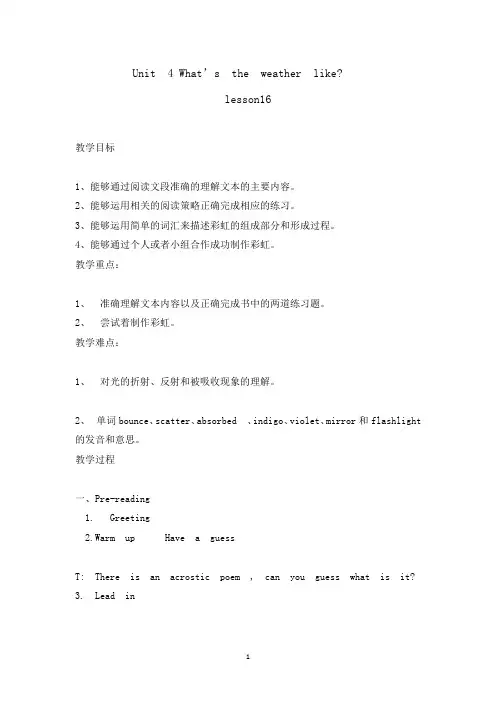
Unit 4 What’s the weather like?lesson16教学目标1、能够通过阅读文段准确的理解文本的主要内容。
2、能够运用相关的阅读策略正确完成相应的练习。
3、能够运用简单的词汇来描述彩虹的组成部分和形成过程。
4、能够通过个人或者小组合作成功制作彩虹。
教学重点:1、准确理解文本内容以及正确完成书中的两道练习题。
2、尝试着制作彩虹。
教学难点:1、对光的折射、反射和被吸收现象的理解。
2、单词bounce、scatter、absorbed 、indigo、violet、mirror和flashlight 的发音和意思。
教学过程一、Pre-reading1.Greeting2.Warm up Have a guessT: There is an acrostic poem , can you guess what is it?3. Lead inT: Do you know the colours?设计意图:通过藏头诗导入,既吸引了学生的兴趣又能为后续活动的开展打下基础。
二、While-reading1. Find the colours of the rainbow. (Scanning)Q: What colours are the rainbows?设计意图:通过跳读,找到彩虹的几种颜色,处理文章的第三段和生词indigo 以及violet。
2.Find the main idea of each paragraph. (Reading for details)1). Paragraph 1Q1: What are rainbows made of?Q2: How can you find the answers?Q3: How can the rainbows happen?设计意图:运用简单的阅读技巧引导学生关注文段第一句和关键词,完成问题;通过分解图的演示,可以使学生更直观的理解彩虹的形成过程,帮助学生理解文段。
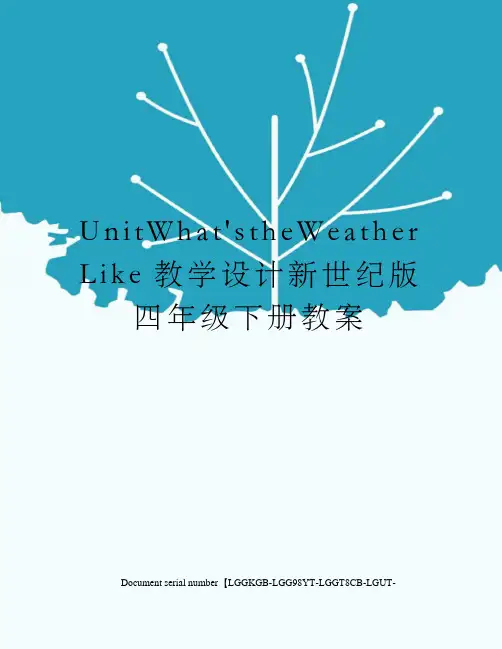
U n i t W h a t's t h e W e a t h e r L i k e教学设计新世纪版四年级下册教案Document serial number【LGGKGB-LGG98YT-LGGT8CB-LGUT-(新世纪版)四年级英语下册教案Unit 9 What’s the Weather LikeThe First PeriodⅠ. Teaching aim:1. New words: rain, sun, wind, snow, cloud, rainy, sunny, windy, snowy, cloudy2. Make some sentences using these words.Ⅱ. Difficult point:Make the sentences.Ⅲ. Preparation:Word cards; some pictures;Ⅳ. Teaching procedure:1. Rhymes2. Revision:Ask and answer:What day is today What’s the date todayWhat’s the weather like today3. New lesson:(1)Introduce: rain, rainyT: What can you see in the picture S: I can see…Read –spell-make the phasePractice in pairs: There is a lot of rain …What’s the weather like today It’s rainy.(2) Introduce: sun, sunny(3)Introduce: wind, windy(4)Introduce: snow, snowy(5)Introduce: cloud, cloudy(6)Play the cassette(7)Look at the book (page63)Make a short dialogue.4. Consolidation:(1)Read the new words.(2) Workbook5. Assignment:(1)Copy the words(2)Recite the words(3)Make the sentences6. Writing on the blackboard:Unit 9Rain sun wind snow cloudRainy sunny windy snowy cloudyThe Second PeriodⅠ. Teaching aim:1. Sentences: W hat’s the weather like It’s …2. Make some dialogue using new sentence.Ⅱ. Difficult point:Make the dialogue.Ⅲ. Preparation:Word cards; some pictures;Ⅳ. Teaching procedure:1. Rhymes2. Revision:Ask and answer:What day is today What’s the date todayWhat’s the weather like today Do you like rainy or windyWhat can you do on a sunny day3. New lesson:(1)Introduce: What’s the weather like It’s…T: Is it a fine day S: Yes.What’s the weather like tomorrow It’s …Practise: What’s the weather like It’s…(2)Introduce: Do you like rainy No, I don’t like it./Yes, I do. Me, neither.(3)Introduce: Foggy , breezy , dry , warm , chilly, humid(4)Play the cassette. The students listen and repeat.(5)In groups of two , the students practise the dialogue in their books.(6)In groups with new words.(7)Look at the book (page65)Make a short dialogue.4. Consolidation:Workbook page 695. Assignment:(1)Copy the words(2)Recite the words and dialogue(3)Make the sentences and dialogue.6. Writing on the blackboard:Unit 9What’s the weather like It’s…The Third PeriodⅠ. Teaching aim:1. Sentences: Can we…/Shall we…2. Make some new dialogue.Ⅱ. Difficult point:Make the dialogue.Ⅲ. Preparation:Word cards; some pictures;Ⅳ. Teaching procedure:1. Rhymes2. Revision:Ask and answer:What’s the weather like today3. New lesson:(1)Introduce: What’s the weather like It’s…Shall we go to the beach Sure...Can we go the zoo this afternoon Ok.(2)Practise: What’s the weather like It’s… Can we/Shall we…(3)Make a short dialogue in pairs,(4)Open the book. Listen to the tape.(5)Practise the dialogue in their books.4. Consolidation:(1)Question and answers(2)On your own.(3)Pair works.5. Assignment:(1)Copy the dialogue.(2)Recite the dialogue(3)Make the new dialogue.6. Writing on the blackboard:Unit 9What’s the weather like …Can we…/shall we…The fourth periodⅠ. Teaching aim:1. Kid’s Palace: Weather2. Read and matchⅡ. Preparation:Word cards; some pictures;Ⅲ. Teaching procedure:1. Rhymes2. Revision: Ask and answer:What’s the weather like today3. New lesson:(1)Introduce some new words: sand, puddle, snowman Spell-Phrase-Sentences(2) Read the text.(3)Play the cassette.(4)Read and match.4. Consolidation:Ask: What weather do you like best WhyWhat can you play What’s your favourite thingDo you like rain5. Assignment:WorkbookWriting on the blackboard:Unit 9 weatherWhat weather do you like I like…The fifth periodⅠ. Teaching aim:1. Music box: /w/ /h/2. RhymeⅡ. Preparation:Word cards; some pictures;Ⅲ. Teaching procedure:1. Rhymes2. Revision: Ask and answer:3. New lesson:(1)Sound: /w/Show some words: where when whichRead after the teacher:/w/Ask: Which words contain /w/sound Why what…(2)wh /h/Show the words: who whose whomRead after the teacher: /h/Ask: Which words contain /h/ sound(3)Play the cassette.(4)RhymeListen-read-make a new rhyme4. Consolidation:WorkbookFill in blank:_ _ere _ _at _ _ich _ _y _ _all_ _o _ _ose _ _om _e _ _ere5. Assignment:Copy /w/ /h/Make some new sentences.6. Writing on the blackboard:Unit 9wh /w/ where when whichwh /h/ who whose whom。
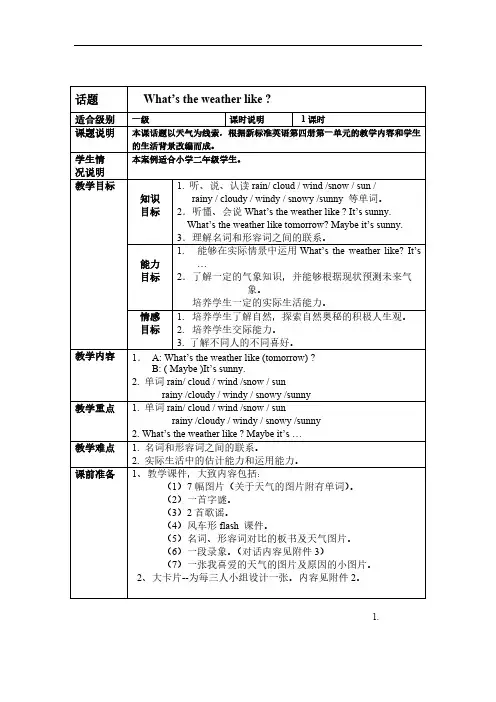
话题What’s the weather like ?适合级别一级课时说明1课时课题说明本课话题以天气为线索,根据新标准英语第四册第一单元的教学内容和学生的生活背景改编而成。
学生情况说明本案例适合小学二年级学生。
知识目标1. 听、说、认读rain/ cloud / wind /snow / sun /rainy / cloudy / windy / snowy /sunny 等单词。
2.听懂、会说What’s the weather like ? It’s sunny. What’s the weather like tomorrow? Maybe it’s sunny. 3.理解名词和形容词之间的联系。
能力目标1. 能够在实际情景中运用What’s the weather like? It’s…2.了解一定的气象知识,并能够根据现状预测未来气象。
培养学生一定的实际生活能力。
教学目标情感目标1.培养学生了解自然,探索自然奥秘的积极人生观。
2.培养学生交际能力。
3. 了解不同人的不同喜好。
教学内容1.A: What’s the weather like (tomorrow) ?B: ( Maybe )It’s sunny.2. 单词rain/ cloud / wind /snow / sunrainy /cloudy / windy / snowy /sunny教学重点 1. 单词rain/ cloud / wind /snow / sunrainy /cloudy / windy / snowy /sunny2. What’s the weather like ? Maybe it’s …教学难点 1. 名词和形容词之间的联系。
2. 实际生活中的估计能力和运用能力。
课前准备1、教学课件,大致内容包括:(1)7幅图片(关于天气的图片附有单词)。
(2)一首字谜。
(3)2首歌谣。
(4)风车形flash 课件。
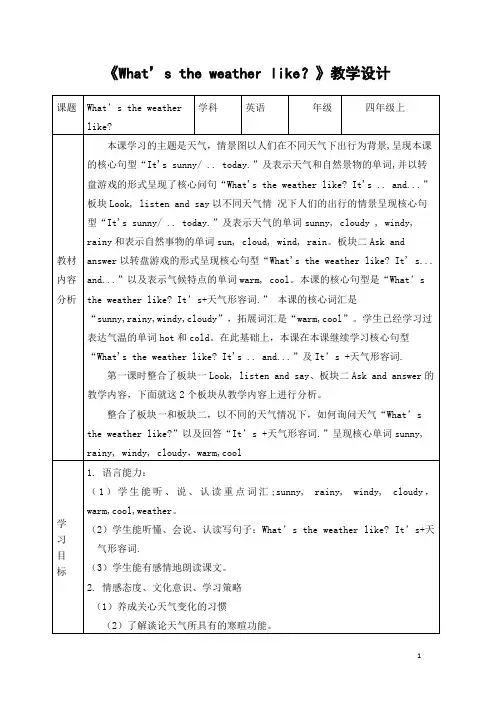
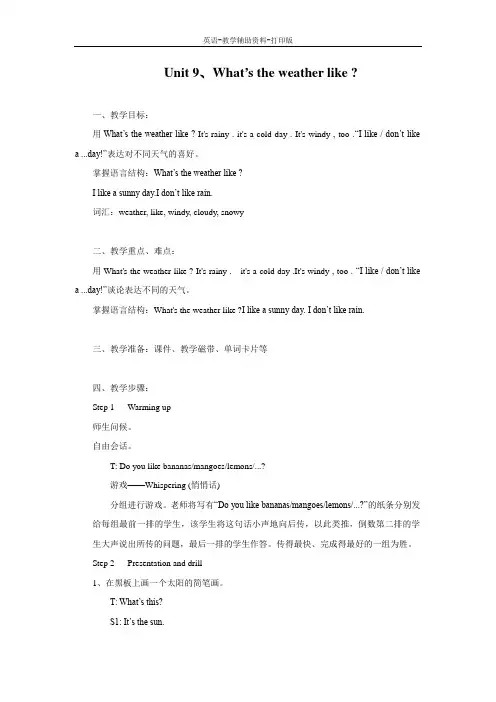
Unit 9、What’s the weather like ?一、教学目标:用What’s the weather like ? It's rainy . it's a cold day . It's windy , too .“I like / don’t like a ...day!”表达对不同天气的喜好。
掌握语言结构:What’s the weather like ?I like a sunny day.I don’t like rain.词汇:weather, like, windy, cloudy, snowy二、教学重点、难点:用What's the weather like ? It's rainy . it's a cold day .It's windy , too . “I like / don’t like a ...day!”谈论表达不同的天气。
掌握语言结构:What's the weather like ?I like a sunny day. I don’t like rain.三、教学准备:课件、教学磁带、单词卡片等四、教学步骤:Step 1 Warming up师生问候。
自由会话。
T: Do you like bananas/mangoes/lemons/...?游戏——Whispering (悄悄话)分组进行游戏。
老师将写有“Do you like bananas/mangoes/lemons/...?”的纸条分别发给每组最前一排的学生,该学生将这句话小声地向后传,以此类推,倒数第二排的学生大声说出所传的问题,最后一排的学生作答。
传得最快、完成得最好的一组为胜。
Step 2 Presentation and drill1、在黑板上画一个太阳的简笔画。
T: What’s this?S1: It’s the sun.T: Do you like the sun?S1: Yes, I do. / No, I don’t like the sun.T: What about you?S2: Yes. I do. / No, I don’tT(指着窗外的太阳或黑板上的太阳):Look at the sun. What's the weather like ?It’s a sunny day.板书并教学单词weather ,like和sunny2、在黑板上画雨的简笔画。
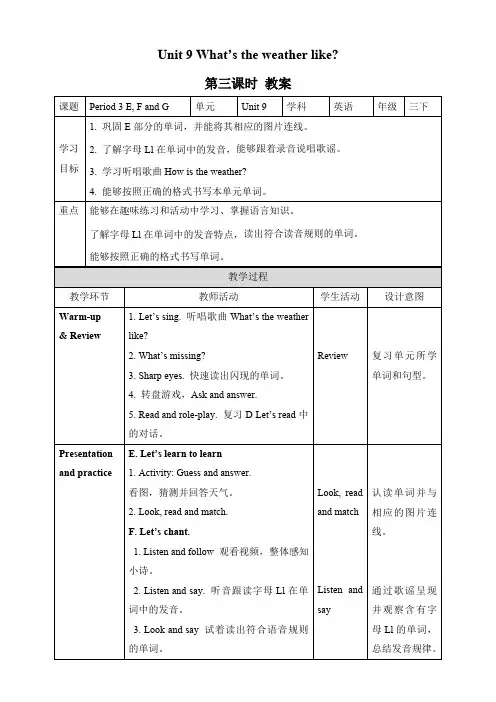
三年级下册英语说课稿-Unit 9 What’s the weather like 第二课时湘少版(三起)一、教材分析本课的教材是三年级下册英语湘少版(三起)Unit 9第二课时What’s the weather like。
本书是湖南教育出版社出版的英语学习教材,适用于小学三年级。
这一单元主要是围绕“天气”这一话题展开,让学生通过图片和情境交际的方式学习和掌握日常用语,培养学生的英语口语能力和自信心。
二、教学目标1.语言技能目标:学生能够较为准确地用英文表述天气情况,描述天气的变化,提高学生的英语口语表达能力;2.学科知识目标:通过本课的学习,提升学生的英语听、说、读、写能力,培养学生的英语学习兴趣,同时让学生了解不同地区的气候情况;3.情感目标:培养学生对英语学习的自信心,增强学生对英语学习的兴趣,激发学生探究和发现问题的能力。
三、教学重难点1.教学重点:让学生熟悉和理解天气情况的表述,提高学生的口语表达能力;2.教学难点:帮助学生理解并掌握天气情况的变化范围,并通过学习句型表达进行模仿学习。
四、教学准备1.教材:三年级下册英语湘少版(三起)Unit 9 What’s the weather like?2.多媒体设备:投影仪、电脑等;3.教学工具:图片词卡片、学生课本、听力材料等。
五、教学过程1. Warm-up(热身)教师出示一张表述天气的图片,用简单的句子进行描述。
让学生通过观察图片和听老师讲解词汇,了解和熟悉天气情况的单词和短语。
2. Presentation(呈现)1.老师出示图片,带领学生学习单词和短语,包括 sunny, rainy, cloudy, snowy。
2.老师通过图片展示让学生学习词汇的对应指向,让学生理解和明确各种气象的图片和单词的对应关系。
3.老师模仿学生简单的问答式进行互动,让学生更好地熟悉语言环境及语境的使用。
3. Practice(练习)1.老师以问答式模式,让学生尝试去描述不同天气下的穿衣搭配。
第二课时Unit 2 What’s the weather like?
环节1 新课导入
设计意图:通过展示图片,引入本课时要学习的话题,让学生更快的融入到课文里来。
环节2 学习活动1-6,并完成相应任务
1.教师教读学生活动1中的新单词。
2.让学生两人一组,一人说中文,另一人说出相应的英文单词。
3.让学生听活动2的录音,把方框中的句子和图片相匹配。
4.教师核对答案。
5.教师播放活动3的录音,学生跟读。
6.教师讲解活动3下对话中的知识点。
7.让学生结对练习对话。
8.让学生完成活动5的任务,教师播放录音,核对答案。
9.让学生观察活动6中的地图,然后两人一组结对练习对话。
设计意图:通过听力和小组合作练习,提升学生的听力和口语能力。
板书设计
练习设计
请完成本课对应训练!。
英语教案 Whats the weather like一般将来时be going 句式和will, shall句式;讲授新词汇;sunny, cloudy, cloud, rainy, wind, windy, snowy,later on, ring up, west, report, north, south, at times, temperature, above, below, worse, foggy, low 1。
-What’s the weather like today?-It’s sunny。
2。
-What was the weather like yesterday?-It was cloudy。
3。
How cold it is today!4。
Will you please +动词原形5。
It’s better to do sth。
语法分析:一般将来时的用法一般将来时指在将来的时间发生的动作或状态,通常有以下几种表达法:1.用“will / shall +动词原形”表示对未来的“预见”,如果句子的主语是人,也可能表达一种“意图”。
(1) You’ll feel better if you take this medicine。
如果你吃这种药,你会感觉更好。
(2) John will meet you at the airport。
约翰将在机场会见你。
2.用“be going to + 动词原形”表示将来打算做的事情或者根据现存的各种因素,推断很快将发生的事情。
(l) What are you going to do tomorrow? 明天你打算做什么?(2) Its going to be sunny tomorrow。
明天可能是晴天(根据所观察的)。
3.“be + v。
–ing”表示按方案安排的,在最近即将发生的动作。
可用于此种用法的动词有:e, go, die, leave,arrive, begin等。
三年级下册英语教案-Unit 9 What’s the weather like 第一课时湘少版(三起)一、教学目标1.知识目标:–掌握本单元单词和短语:weather, sunny, rainy, snow, cloudy, windy, hot, cold, warm等。
–能听、说、读、写句型“What’s the weather like?”和回答句型“It’s sunny/rainy/snowy/cloudy/windy/hot/cold/warm.”。
2.能力目标:–能用所学单词和句型描述天气情况。
–能在英语环境中自信地表达自己对天气的看法。
3.情感目标:–培养学生观察天气的好习惯。
–通过学习本单元内容,增强学生的环保意识,让他们从小开始爱护环境。
二、教学重难点1.教学重点:–听、说、读、写本单元的单词、短语和句型。
–能够描述不同天气的特征,培养观察和判断的能力。
2.教学难点:–与天气有关的词汇和句型的掌握。
–瞬间判断天气状况的能力。
三、教学准备1.教材:湘少版三年级英语下册。
2.教具:PPT,单词卡片。
3.学具:绘本《The Weather》。
1. Warming up1.Greet the students, and ask them some questions about the weather.2.Show some pictures of different types of weather (sunny, rainy, snowy, cloudy, windy) and ask the students to guess what each of them is.2. Presentation1.Teach the new words and phrases using PPT and word cards: weather, sunny, rainy, snow, cloudy, windy, hot, cold, warm.e PPT to introduce the sentence pattern “What’s the weather like?” and the corresponding responses: “It’ssunny/rainy/snowy/cloudy/windy/hot/cold/warm.”3.Model the sentence pattern and ask the students to repeat after you.3. Practice1.Ask the students to work in pairs to practice the sentence pattern by asking and answering each other’s questions about the weather.2.Call several pairs to act out their conversations in front of the class.4. Application1.Show the students some pictures of different types of weather. Ask them to describe what they see using the sentence pattern “What’s the weather like?” and the corresponding responses.e the word cards to create a word wall, and ask the students to identify the different types of weather and their related words.3.Read the storybook “The Weather” and ask the students to complete the corresponding worksheets.5. Extension1.Ask the students to use their new vocabulary to write a short paragraph about their favorite type of weather.2.Show some pictures of people engaging in different activities under different types of weather. Ask the students to discuss which activities are suitable for each type of weather.1.Recap the new words, phrases and sentence pattern.2.Review the types of weather and ask the students to describe them.3.Ask some students to share their paragraphs about their favorite types of weather.六、教学反思This lesson is designed to teach students about the different types of weather and how to describe them using the sentence pattern “What’s the weather like?” and the corresponding response. The students were engaged throughout the lesson, and they showed good understanding of the new vocabulary and how to use it in sentences. However, I think I could have incorporated more activities to reinforce the students’ learning, such as singing a weather-related song or playing a weather-related game. Overall, this lesson was successful in achieving its goals, and I look forward to teaching the next lesson in this unit.。
《What’s the weather like?》教学设计课程名称What’s the weather like?授课人王倩学校名称济源市太行路学校教学对象初二学生科目英语课时安排40分钟一、教材分析本课是该章节的词汇教学部分,通过呈现与本单元话题“自然灾害”相关的“天气”的词语,指导学生有效地学习和掌握。
笔者在设计教案时按照自己对课文的理解,围绕课文的主题,设计了四个教学步骤,在教学过程中辅以多媒体网路课件。
旨在通过这些教学活动,扩充有关天气的词语以及他们之间名词和形容词的转换,提高学生对天气用语的语用能力,与实际生活相联系,最终达到增强学生理解如何从日常生活做起保护环境,防灾减灾的情感态度的培养目的。
二、教学目标及难重点(知识与技能,方法和过程,情感态度与价值观)1.教学目标1)掌握表述天气的词语名词与形容词的转换。
2)学会用这些词语进行由易到难的句型表述的训练。
3)对学生开展由天气到恶劣天气之间产生原因的引导。
4)让学生增强环境保护的意识,从小事做起预防人为因素的不良天气的产生。
2.教学重点和难点1)学会词形准确转换和应用。
2)会用天气表述的词语进行简单的天气预报。
3)学会与人交流不良天气情况的预防办法。
三、教学策略选择与设计1.交际法2.任务型教学法3.合作学习四、教学环境及设备、资源准备教学环境:网络环境学生准备:无教师准备:网络课件教学资源:网络课件五、教学过程教学过程教师活动学生活动媒体设备资源应用分析课前活动Sing an English song Sing an English song1Step 1.:Talking about weatherActivity 1:Introducing mywebsite.Activity 2 : Playing a guessing game.Activity 3: Learning how to turn a noun into an adjective one.Activity 4: Let’s vote!Hello, boys andgirls. Welcome to myclass. During the break,we’ve appreciated anEnglish song. It’s aboutweather. So, today wewill learn somethingabout weather. We aregoing to learn it with thehelp of my website.Look! Here it is! I’vealso prepared somewebsites for you, whichwill help you get someuseful information aboutour topic. You can surf itif you have time afterclass.Now, let’s play a game. I amgoing to introducedifferent kinds ofweather in English,please guess what it isabout. If you know theanswer, just stand up andtell me.The teacher shows a group ofwords as an examplein order to find outthe rule together. Thestudents will try tofinish all the othergroups bythemselves.Which kind of weather doyou like best? Why?Please vote for yourfavourite weather, anddon’t forget to tell us thereason.Try to understand what the classwill be like.Play the game.Practise on the computer andcheck the answer by themselves.V ote and have a discussion.(1)通过网络的形式,让学生了解更多相关天气的知识,作为开课前的热身和知识储备。
(2)大部分学生对这种教学方式有很浓的兴趣,可以及大的调动整个课堂气氛,以缓解开场时的沉闷,让学生尽快进入课文学习的状态。
[教学反思](1)让学生对今天所展开的话题,有更加形象的了解和认识。
(2)通过抢答的方式展开该项活动,借助个别特别活跃的学生去感染整体,让学生有兴趣开口去“说”。
(1)这是一个学生自主学习的过程。
通过教师传授名词和形容词变化的规律,然后自主训练该规律的运用。
并能进行及时自我评判,提升了课堂效率。
(2)充分利用了网络教学的便利条件,教师能够随时了解学生学习情况展开针对性教学。
(1)让学生灵活的进行相关天气的名词和形容词之间的转换训练。
(2)体现教学过程中的多样化,允许学生用开放性的思维去完成这个教学活动。
让学生各抒己见,没有固定的框架去判断正误,给学生提供充分发挥个性的平台。
(3)师生之间通过留言的形式进行网络的互动和交流,大大拉近了师生的2Activity 5: Making a dialogueStep 3. Weather report Activity 6: Which is a better one?Activity 7: Trying to be a weather reporter.Step 4: Natural disasters Activity 8: Some natural disastersActivity 9:A special weather report.Activity10:Writing Students will finish adialogue which is about aneasy weather report fromMonday to Friday.I am going to show youtwo different kindsof weather report.Would you pleasetell me which one doyou like better?Why?Most of us like the secondweather report. Wouldyou try to be a weatherreporter like that? Lookat this map. I want youto make a weather reportby yourselves.As we know, if it rains toomuch. There will be arainstorm. How about ifit snows too much? Yes,we call them disasters.Now I am going to showyou a special weatherreport, after watching it,will you tell me whatcan you learn from it?After watch the video, willyou write a compositionabout “A special weatherreport”?Practise on the computer and havea discussion.Watch and share their own ideaswith the classmates.Make a weather report.Learn more about disaster.Watch and think.Write.距离,增进了他们的感情。
(1)仍然是以学生自我训练、自我评价的方式,综合测试学生对于该步骤的掌握情况。
(2)通过天气预报的方式,对该部分的内容进行了小结。
训练题综合性较强。
(1)借助多媒体,通过视频向学生展现风格迥异的天气预报方式。
(2)幽默诙谐的模板示范让学生身临其境感受一个优秀天气预报员的魅力,对于接下来活动顺利、积极地开展埋下伏笔。
(1)学生可以通过flash制作中自由移动的物品,将天气情况和生活实际相结合。
(2)学生对天气预报精彩解说,是将课本知识与实际生活的完美结合。
1)由天气的表述上升到灾难的介绍,将本课的知识点与整个单元的主题巧妙地结合起来。
(2)让学生在网上搜索相关的灾难知识,为下一个教学步骤的展开做好铺垫。
(1)通过一个公益广告,引出本课的主题:保护环境,防灾减灾。
(2)这个教学步骤是学生情感目标的实现,是整堂课的升华。
学生通过一堂课,不仅学会了书本上的知识,更是明白了一个道理。
(1)借助网络留言板的方式,将课堂中师生的交流从课内延伸到了课外。
(2)课堂上的大量语言输入为这项作业打下良好基础,写的训练也是英语综合能力训练的最佳提升方式之一。
3六、教学评价设计优秀课例七、课后反思本堂课就是通过天气--- 天气的使用----- 自然灾害------- 自然灾害的防护,这样一个层层递进,逐步深入的方式开展教学。
学生在课堂中也实现了由知识目标到技能目标以及到情感目标的升华。
学生在教学过程中始终发挥他们的主动作用,积极参与其中,发现问题,探究课堂,解决问题。
扮演好了课堂主人的角色。
而教师扮演一名引导者,指导学生学习。
在课堂教学中,信息技术发挥了充分的优势,帮助学生自主学习、自主研究顺利进行。
4。